| Information
Service of
the Serbian Orthodox Church
Avgust 18, 2004

INTERRELIGIOUS CONFERENCE ON RELIGION, PEACE
AND THE OLYMPIAN IDEAL HELD IN ATHENS
On the occasion of this year’s Olympic Games in Athens an International
Religious Conference on the theme of Religion, Peace and the
Olympian Ideal was held in the elite Amarusion quarter of Athens
on August 10-11 under the high patronage of His All-Holiness
Ecumenical Patriarch Bartholomew of Constantinople and President
Konstantin Stefanopoulos of Greece and organized by the Brussels
representative office of the Constantinople Patriarchate and
the municipality of Amarusion.
The conference included representatives of the Christian (Orthodox,
Roman Catholic and Protestant), Muslim, Jewish and Buddhist religious
communities. It is noteworthy that His All-Holiness Patriarch
Bartholomew took part in the conference not only by welcoming
the participants but also as a presenter.
The conference began on August 10, 2004 at 6:30 p.m. with the
welcoming remarks of His All-Holiness Patriarch Bartholomew and
Amarusion mayor Panaiotis Gianikos. The same evening there were
several other welcoming and introductory speeches and a formal
reception for all participants and guests.
On August 11 an all-day session of the conference took place,
addressing three basic topics: religion and the appeal for peace,
the Olympian ideal and peaceful coexistence of nations, and religion
and the Olympian ideal. At the end of the conference participants
unanimously adopted the Olympian peace charter, i.e. the declaration
of this important interfaith conference.
On behalf of the Serbian Orthodox Church and in the capacity
of envoy of His Holiness Serbian Patriarch Pavle taking part
in the conference was His Grace Bishop Irinej of Backa. Bishop
Irinej conveyed a personal message from the Serbian Patriarch
and was also one of the presenters on the topic of the Olympian
ideal and peaceful coexistence of nations.
More information about the conference will be appearing in the
next issue of Pravoslavlje (Orthodoxy – the official publication
of the Serbian Patriarchate) and on this Web site.

CONFERENCE ON THE SERBIAN PEOPLE IN MONTENEGRO: AN AFFIRMATION
OF THE NATIONAL ISSUE AND DEFENSE OF HUMAN RIGHTS The Serbian People’s Party has organized a scientific and expert
conference on the theme The Serbian People in Montenegro: Affirmation
of the national issue and defense of human rights to be held
in Podgorica on August 21-22, 2004. Serbian People’s Party president
Andrija Mandic will open the conference and speakers will include
Princess Jelisaveta Karadjordjevic. Among the participants will
be leading scientists, spiritual leaders, artists and experts
from both Montenegro and Serbia concerned with these topics:
Bishop Joanikije of Budimlje and Niksic, Professor Dr. Bogoljub
Sijakovic, Professor Dr. Radmilo Marojevic, Professor Dr. Savo
Lausevic, Dr. Slavenko Terzic, Dr. Momcilo Vuksanovic, Dr. Vladimir
Jovicevic, Fr. Velibor Dzomic, Budimir Aleksic, Vukic Ilincic,
Zarko Lekovic, Zelidrag Nikcevic, Milutin Micovic, Novak Radulovic,
Goran Danilovic, Predrag Vukic, Aleksandar Rakovic, Novica Djuric
and others.
Serbs in Montenegro are presently in the worst position they
have been in since World War II and are exposed to ethnic discrimination.
Consequently the conference will formulate and adopt a platform
of its basic national interests to be presented to the Government
of Montenegro, Serbia, the European Union, the United States
and Russia. In the interest of preserving the Serbian national
identity in Montenegro the Serbian people will request the establishment
and institutionalization of political, linguistic, religious,
educational, cultural and every other form of autonomy of the
Serbian people throughout Montenegro.

LITURGICAL LIFE RENEWED IN BANJSKA MONASTERY 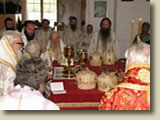 His Holiness Serbian Patriarch Pavle served Holy Hierarchal
Liturgy with the concelebration of Bishops of the Serbian Orthodox
Church in the monastery of Banjska near Zvecan in northern Kosovo.
In front of several thousand citizens from throughout the land
and abroad, the ceremony was also attended by guests from Greece,
the abbot of the Mt. Athos monastery of Xiropotam and his monks,
the Serbian minister for relgions Milan Radulovic and representatives
of the Coordinating Center for Kosovo and Metohija. Also present
were members of the royal house of Karadjordjevic, who contributed
to the renewal of the monastery of Banjska. His Holiness Serbian Patriarch Pavle served Holy Hierarchal
Liturgy with the concelebration of Bishops of the Serbian Orthodox
Church in the monastery of Banjska near Zvecan in northern Kosovo.
In front of several thousand citizens from throughout the land
and abroad, the ceremony was also attended by guests from Greece,
the abbot of the Mt. Athos monastery of Xiropotam and his monks,
the Serbian minister for relgions Milan Radulovic and representatives
of the Coordinating Center for Kosovo and Metohija. Also present
were members of the royal house of Karadjordjevic, who contributed
to the renewal of the monastery of Banjska.
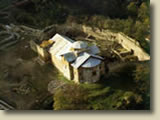 In this endowment of King Milutin built at the beginning of
the 14th century there have been no monks and Holy Liturgy has
not been served for the past 520 years; only the people visited
the old walls. The monastery now has a brotherhood of four monks,
headed by Protosindjel Simeon as the monastery elder. They first
renewed the dormitory and moved into it; then the renewal of
the monastery began, which has now been consecrated by the Patriarch. In this endowment of King Milutin built at the beginning of
the 14th century there have been no monks and Holy Liturgy has
not been served for the past 520 years; only the people visited
the old walls. The monastery now has a brotherhood of four monks,
headed by Protosindjel Simeon as the monastery elder. They first
renewed the dormitory and moved into it; then the renewal of
the monastery began, which has now been consecrated by the Patriarch.
 In his sermon His Holiness Patriarch Pavle emphasized that this
church, like all churches, reminds the Serbian people of its
past history. “We need to become a match for these times we live
in and do what we can, following the model of our ancestors,
who survived five hundred years of enslavement,” said the Patriarch,
blessing the monks and the Serban people. In his sermon His Holiness Patriarch Pavle emphasized that this
church, like all churches, reminds the Serbian people of its
past history. “We need to become a match for these times we live
in and do what we can, following the model of our ancestors,
who survived five hundred years of enslavement,” said the Patriarch,
blessing the monks and the Serban people.
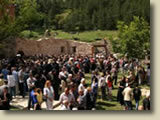 His Grace Bishop Artemije of Raska and Prizren said that this
is “a great day, the day of the resurrection of the endowment
of King Milutin, adding that the monastery is “a witness to Orthodox
faith and a road sign for the Serbian people to eternal life”.
“Kosovo is the land of every Serb and the land of every person,”
said Bishop Artemije. His Grace Bishop Artemije of Raska and Prizren said that this
is “a great day, the day of the resurrection of the endowment
of King Milutin, adding that the monastery is “a witness to Orthodox
faith and a road sign for the Serbian people to eternal life”.
“Kosovo is the land of every Serb and the land of every person,”
said Bishop Artemije.
Minister Radulovic said that “faith and memory cannot be desecrated
and monasteries that have been destroyed can be renewed”. He
expressed the conviction that all monasteries destroyed in Kosovo
will be renewed “monasteries have a special energy. They are
not just buildings but seem to have been put on Earth from the
heavens.”
Exactly at noon a formal academy was held in the monastery courtyard
with the choir and monks of the monastery of Decani, poets Slobodan
Rakitic and Milan Mihajlovic, theatrical artists Vesna Pavlovic
and Momir Bradic, and the White Linen traditional folk music
group among the participants. KFOR, UNMIK and the Kosovo Police
Service reinforced all roads to Banjska, and a special security
checkpoint was set up on the Kosovska Mitrovica-Raska road near
the monastery. There were no incidents during the ceremony.
The monstery of Banjska, from which church bells can be heard
again after 520 years, is located near the village of Banjska
in the municipality of Zvecan, north of Kosovska Mitrovica. This
pearl of medieval culture is the endowment of King Milutin, who
built the monastery during the period from 1312-16. After the
king’s death his holy relics were placed in the church of the
monastery of Banjska; as the intended site of the king’s tomb,
this church was far more richly decorated than any of Milutin’s
other 40-odd endowments. The monastery itself was built on the
site of a much older church and during the rule of Milutin’s
father, King Uros I, in the 13th century a Diocese of Banjska
existed seated in Banjska. After the Battle of Kosovo in 1389
the monks transferred the relics of King Milutin to Trepca and
later they were transferred to Sophia, Bulgaria, where they still
rest today in the church of the Holy Alexander Nevsky. In the
17th century the Turks turned the monastery of Banjska into a
mosque. The monastery suffered terrible destruction in 1689 and
the first serious efforts to research it did not occur until
the liberation of Kosovo and Metohija from the Turks in 1912.
In 1938, following completion of reserach and excavation of the
foundations of dormitories nearby, the church was partially renewed
and a temporary roof placed on it. The restoration of this holy
shrine began in the last three years with the mediation of the
Serbian Government, and especially of the Coordinating Center
for Kosovo and Metohija.

STATUE OF MOTHER OF GOD OF SOKOLICA ON EXHIBIT  On
Sunday, August 15, 2004 the marble statue of the Mother of
God of Sokolica from the monastery of Sokolica near Kosovska
Mitrovica has been exhibited in the National Museum in Belgrade,
where it will be on display until August 24. The statue of the
Most Holy Mother of God with the Christ child was one of the
exponents representing Serbian medieval art at the monumental
exhibition Byzantium: Faith and Glory (1261-1557) held at the
Metropolitan Museum of Art in New York City from mid-April to
the beginning of July 2004. After the exhibition the sculpture
was returned to the monastery of Sokolica, where it was brought,
according to tradition, as a holy relic more than 500 years ago
by monks fleeing before the Turks. On
Sunday, August 15, 2004 the marble statue of the Mother of
God of Sokolica from the monastery of Sokolica near Kosovska
Mitrovica has been exhibited in the National Museum in Belgrade,
where it will be on display until August 24. The statue of the
Most Holy Mother of God with the Christ child was one of the
exponents representing Serbian medieval art at the monumental
exhibition Byzantium: Faith and Glory (1261-1557) held at the
Metropolitan Museum of Art in New York City from mid-April to
the beginning of July 2004. After the exhibition the sculpture
was returned to the monastery of Sokolica, where it was brought,
according to tradition, as a holy relic more than 500 years ago
by monks fleeing before the Turks.

RESTORATION OF PAJA JOVANOVIC’S FAMOUS MASTERPIECE THE MIGRATION
OF THE SERBS BEGINS 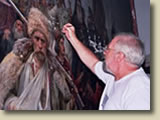 A few months ago preparations began for the restoration of the
masterpiece Seoba Srbalja (The Migration of the Serbs) by famous
Serbian painter Paja Jovanovic. The painting was commissioned
at the end of the 19th century (1896) by the Serbian Church,
i.e. then Patriarch Georgije Brankovic. This large (5.8 meters
x 3.8 meters) composition was kept in the Metropolitanate-Patriarchate
in Sremski Karlovci, which was the seat of the Serbian Church
(and Metropolitanate of Karlovci) during the Turkish occupation
of Kosovo and Metohija. At the beginning of World War II the
Ustashe (Croatian Nazi Fascists) cut the painting out of its
frame, rolled it up, folded it twice vertically and took it to
Zagreb. After the war, thanks to Professor Dr. Radoslav Grujic,
then director of the Museum of the Serbian Orthodox Church, at
the request of the Serbian Church some of the looted treasures
were returned from the territory of the Ustashe Independent State
of Croatia and returned to the Serbian Orthodox Church. Among
the precious objects retrieved was the painting Seoba Srbalja.
This important historical work was then displayed in the National
Museum in Belgrade and ultimately to the Patriarch’s residence,
i.e. to the conference room where meetings of the Holy Assembly
of Bishops are held which is located in the on-site church of
St. Simeon the Myrrh-gusher. A few months ago preparations began for the restoration of the
masterpiece Seoba Srbalja (The Migration of the Serbs) by famous
Serbian painter Paja Jovanovic. The painting was commissioned
at the end of the 19th century (1896) by the Serbian Church,
i.e. then Patriarch Georgije Brankovic. This large (5.8 meters
x 3.8 meters) composition was kept in the Metropolitanate-Patriarchate
in Sremski Karlovci, which was the seat of the Serbian Church
(and Metropolitanate of Karlovci) during the Turkish occupation
of Kosovo and Metohija. At the beginning of World War II the
Ustashe (Croatian Nazi Fascists) cut the painting out of its
frame, rolled it up, folded it twice vertically and took it to
Zagreb. After the war, thanks to Professor Dr. Radoslav Grujic,
then director of the Museum of the Serbian Orthodox Church, at
the request of the Serbian Church some of the looted treasures
were returned from the territory of the Ustashe Independent State
of Croatia and returned to the Serbian Orthodox Church. Among
the precious objects retrieved was the painting Seoba Srbalja.
This important historical work was then displayed in the National
Museum in Belgrade and ultimately to the Patriarch’s residence,
i.e. to the conference room where meetings of the Holy Assembly
of Bishops are held which is located in the on-site church of
St. Simeon the Myrrh-gusher.
 The Holy Assembly of Bishops of the Serbian Orthodox Church
approved the restoration and conservation of this exceptionally
valuable work of art in 1996, on the occasion of the 100 year
anniversary of its creation. However, priority was given to the
protection of church artifacts dislocated as a result of wartime
activities. The conservation and restoration of Paja Jovanovic’s
Seoba Srbalja was entrusted to Mr. Jovan Pantic, painter and
consultant to the National Museum. Mr. Panic has recently done
extensive work on the paintings of Paja Jovanovic, especially
on the restoration of 12 works that had been stolen from the
Museum in Arandjelovac. Considerable time was dedicated to chemical
analysis and reproduction in order to preserve the work in its
existing state while at the same time better establishing the
extent of damage. Every detail, every figure and instance of
damage was photographed with over 800 photos taken. All details
were documented with a digital camera and then with ultraviolet
and infrared photography. The picture was then taken from its
location, the mounting (frame) was reinforced, and the canvas
stretched and affixed. Upon completion of these preparatory tasks
the actual conservation and restoration of the painting began.
The work is being conducted under the supervision of the custodian
of the Museum of the Serbian Orthodox Church and a committee
of the Holy Assembly of Bishops. According to the plan of work
the preservation of Seoba Srbalja is expected to be complete
by October 2004. Funds for restoration and conservation of the
painting have been provided by the Ministry of Culture and Media
of the Republic of Serbia. The Holy Assembly of Bishops of the Serbian Orthodox Church
approved the restoration and conservation of this exceptionally
valuable work of art in 1996, on the occasion of the 100 year
anniversary of its creation. However, priority was given to the
protection of church artifacts dislocated as a result of wartime
activities. The conservation and restoration of Paja Jovanovic’s
Seoba Srbalja was entrusted to Mr. Jovan Pantic, painter and
consultant to the National Museum. Mr. Panic has recently done
extensive work on the paintings of Paja Jovanovic, especially
on the restoration of 12 works that had been stolen from the
Museum in Arandjelovac. Considerable time was dedicated to chemical
analysis and reproduction in order to preserve the work in its
existing state while at the same time better establishing the
extent of damage. Every detail, every figure and instance of
damage was photographed with over 800 photos taken. All details
were documented with a digital camera and then with ultraviolet
and infrared photography. The picture was then taken from its
location, the mounting (frame) was reinforced, and the canvas
stretched and affixed. Upon completion of these preparatory tasks
the actual conservation and restoration of the painting began.
The work is being conducted under the supervision of the custodian
of the Museum of the Serbian Orthodox Church and a committee
of the Holy Assembly of Bishops. According to the plan of work
the preservation of Seoba Srbalja is expected to be complete
by October 2004. Funds for restoration and conservation of the
painting have been provided by the Ministry of Culture and Media
of the Republic of Serbia.
Slobodan Mileusnic,
Director of the Museum of the Serbian Orthodox Church
The great Serbian realist painter Paja
Jovanovic was born in
1859 in Vrsac and died in 1957 in Vienna. He studied in Munich
and Vienna, where his professors suggested that he seek inspiration
for his paintings in the life of the Balkan peoples. Consequently,
he traveled not only throughout the Balkans but also in Italy,
Constantinople, Egypt and the Caucus, collecting motifs for group
scenes which later resulted in perhaps the best paintings of
the Serbian realist school (e.g., Igra sa macevima ( The Fencing
Lesson), Guslar( The Pirate), Arnautski dvoboj ( The Albanian
Duel), Pricanje o boju na Kosovu ( The Saga of the Battle of
Kosovo), Boj petlova ( The Cock Fight) and others). Considered
to be among Jovanovic’s greatest creations is the painting Seoba
Srba pod Patrijarhom Arsenijem Carnojevic (The Migration of the
Serbs under Patriarch Arsenije Carnojevic) commissioned by Serbian
Patriarch Georgije Brankovic for the Millennium Exhibition in
1896 in Budapest. Patriarch Arsenije is depicted with a cross
in his hand and Vice Duke Monasterlija with an armed company
of men. This monumental composition represents “the climax of
Serbian historical painting in the 19th century”. Similar in
character is the famous Proglasenje Dusanovog carstva (The Coronation
of the Emperor Dushan) painted in 1990 for which won first prize
at the World’s Fair in Paris in 1900. The same year Paja Jovanovic
was elected to the Serbian Academy of Sciences. Even after this
recognition Jovanovic dedicated himself to historical themes,
painting the masterpiece Sveti Sava miri bracu (St. Sava Reconciles
the Brothers) and Sveti Sava krunise Prvovencanog (St. Sava Crowns
the First-Crowned) for the Cathedral in Novi Sad (reproductions
are in the Cathedral in Sremski Karlovci). In the same group
is Spaljivanje mostiju Svetog Save (The Burning of the Relics
of St. Sava) done for the Cathedral in Sremski Karlovci, Dusanova
zenidba (The Marriage of Dushan) and Takovski ustanak (The Takovo
Rebellion). Paja Jovanovic also painted many portraits of the
European cultural and political aristocracy. 
CHURCH CONSECRATED IN BABICI On Sunday, August 8, 2004 the memorial church dedicated to the
Holy Great-martyr Panteleimon was consecrated in Babici in the
Diocese of Bihac and Petrovac. Construction of the church began
in 1993 with the intent of making it a memorial to the martyrs
of Babici and Janje who were murdered by the Ustashe (Croatian
Nazi Fascists) during World War II. The church was consecrated
by His Grace Bishop Hrizostom of Bihac and Petrovac with the
concelebration of the clergy and priest-monks of the Dioceses
of Bihac and Petrovac, Osijek Polje and Baranja, and Sumadija.
A great number of people attended the formal and historic ceremony
of the consecration of the church; after Holy Hierarchal Liturgy
was served in the newly consecrated church, Bishop Hrizostom
presented acknowledgements (gramata) to those most deserving
for the construction of the church, including the parishioners
of the parish of Babici, the Church Parish of Babici, Babici
parish priest Radoslav Stankovic, and priest Vlatko Golic, who
began building the church.

REQUIEM SERVICE HELD IN GRMUSA On the feast of the Holy Great-martyr Panteleimon, on August
9, 2004, a requiem service was held in the village of Grmusa
near Bihac for everyone killed in this region. The requiem service
was held in the abandoned and destroyed church by the abbot of
the monastery of Rmnja, Serafim Kuzic, and Protosindjel Sergije
Karanovic, the administrator of the parish of Bihac. Some 150
displaced local residents of Grmusa, most of whom now live in
Gradiska and Novi Grad, arrived in organized fashion to the service
in order to pray for their loved ones in the location where they
were killed and show their love for their native region which
they have not forgotten.

INTERVIEW OF HIS GRACE BISHOP GERASIM FOR VECERNJE NOVOSTI Thousands of Serbs from throughout Croatia gathered on July
26, 2004 in Gomirje to see His Holiness Serbian Patriarch Pavle,
all the Serbian bishops and the ordination of the youngest among
them, Gerasim, who at the age of 32 became a bishop in the church
at Gomirje where he will be seated as the Bishop of Gornji Karlovac.
“For the church this means younger people in its ranks and I
will strive through my work to contribute to the dynamics. For
me personally it means a lot even though I was also very young,
27 years of age, when I became the abbot of the monastery of
Krka in Dalmatia,” says the young Bishop Gerasim.
“It is the first time that the Patriarch has consecrated a Bishop
on the territory of Croatia; the tradition has been for the consecration
to take place in Belgrade and for the bishop later to be enthroned
in the diocese to which he has been elected. If everything had
been as it should be, that would have been in Karlovac. But the
church there has been destroyed and the Bishop’s residence has
been destroyed; thus, my seat is temporarily here at Gomirje.”
What is the current status of the church in Karlovac? It was
dynamited several times during the previous war (the Croatian
war of secession from the former Socialist Federal Republic of
Yugoslavia). Will the state now begin its restoration?
Recently a meeting was held between the Minister of Culture
of the Republic of Croatia, Mr. Biskupic, and our Bishops. They
discussed the reconstruction of the church in Karlovac and the
(Croatian) Government has set aside some funds so the renewal
should begin in September 2004. Both the church and the residence
were dynamited and consequently the integrity of the structure
has been destroyed. The damage assessment is tremendous. Some
of the treasures have been preserved and are currently in a museum
in Zagreb so we expect to get those back.
When do you hope to return to Karlovac?
It’s hard to say! We’ll see in the autumn when reconstruction
work begins. I believe it will be soon.
Today is the anniversary of Operation Storm, which Croatia is
celebrating as “Homeland Thanksgiving Day”. You were in the monastery
of Krka until Oluja and you returned to the monastery after it.
Did anyone stay in the monastery during the attack?
No one stayed in Krka. Every left. They left with the Serbs
to the Serbian part of Bosnia. I was the first to return here
in 1998.
What did you find?
Chaos, of course. What else could have be expected. The roofs
of the monastery and dormitories were whole and thus the hope
remained of starting from the beginning. Everything else, of
course, had been looted and destroyed.
Was anything later found?
Nothing! As far as the library is concerned, everything was
scattered; we picked up the books and returned them to their
shelves because books are valuable. The artifacts that were in
the monastery were removed to Belgrade at the beginning of the
war and they are in the museum of the Serbian Orthodox Church.
We will return them when we can.
During the most recent war there were not a lot of clashes between
Serbs and Croats in this area. That’s why there were no problems
with the monastery.
Luckily, that’s true. There were provocations here, too, but
there was no war and people stayed in their homes. That makes
things easier.
Perhaps the mentality of the mountain dwellers and the Dalmatians
is another reason?
I have observed a difference. There is certainly a difference
in mentality! In Dalmatia people are a little fiercer, presumably
because on the barren rocks they are “mad as snakes”. Here
they are tamer, and wise people worked on preventing clashes.
Someone realized that what was happening could not end well.
No war ends well. Reason prevailed.
Are tensions decreasing and relations becoming more normal among
the people?
There are still a lot of provocations. Especially when some
sort of anniversaries is being celebrated, like today, for example,
the Serbs are mostly in their homes. We try not to go out. There
are still a lot of these provocations in Dalmatia, Lika and cities
that were damaged during this war.
According to the press, recently relations between the Serbian
Orthodox Church and the Croatian state have been on the up and
up.
I believe that they will get even better. This is just the beginning.
We have no other choice; we live together. We have also been
living on this territory for centuries. I believe that these
relations will continue to improve.
How much of the Serbian Orthodox Church’s property has been
returned?
It has been returned in Rijeka and in Zagreb. In Karlovac it
has not been returned; there are still a lot of buildings here
that have not been returned. In Dalmatia – Krka, Sibenik, Zadar,
Split – the Church has a lot of property but nothing has been
returned! I believe that it will be and that the law that has
already been passed on the restoration of church property will
soon be implemented.
Serbs and Croats in the Dalmatian regions have more or less
the same mentality.
I have a habit of saying of Dalmatia, which I know quite well
and so I can say it, that they are one and the same people. Serbs
and Croats in Dalmatia are neither Serbs nor Croats; they are
Dalmatians.
Written by Nino Kopac
Source:
Vecernje Novosti daily, Belgrade, August 16, 2004

[Serbian
Translation Services]
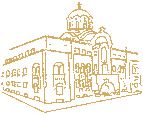
Copyright © 1999-2004 by
The Information Service of
the Serbian Orthodox Church
11000 Belgrade
Kralja Petra I no.5
+381 11 3282 596
e-mail
|

